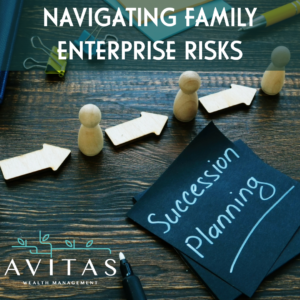 When asked about succession planning, many people outside of a family business think of “Succession” a gripping drama series that follows the power struggles and family dynamics of the wealthy Roy family, owners of a global media and entertainment conglomerate, as they vie for control of the company amidst betrayal, intrigue, and ambition.
When asked about succession planning, many people outside of a family business think of “Succession” a gripping drama series that follows the power struggles and family dynamics of the wealthy Roy family, owners of a global media and entertainment conglomerate, as they vie for control of the company amidst betrayal, intrigue, and ambition.
In real life, succession planning is less dramatic but families recognize that control over a family business often fails at the transfer of control between generations due to a lack of resources, governance, innovation, and learning. Assessing these elements is critical for the sustainability and success of family businesses through generational transitions.
Lack of Resources
The lack of resources, including financial, human, and operational resources, can significantly hinder the ability of the next generation to sustain and grow the family business. Without adequate resources, the successor may struggle to implement necessary changes, invest in new technologies, or even maintain the business’s day-to-day operations effectively.
Governance Challenges
Proper governance structures are essential for the long-term success of family-owned businesses. Without these structures, family-owned businesses may encounter a range of problems that can impact their success and viability. These problems include role confusion among family members, decision-making based on personal preferences rather than business needs, and a lack of accountability and transparency. Governance can also help in managing family conflicts, which are common in family businesses and can significantly affect the business’s progress.
Innovation and Learning
Innovation is crucial for the survival and growth of any business, including family businesses. A systematic literature review [1] highlights the importance of innovation in the context of succession in family businesses. It identifies three clusters in literature: the impact of succession on innovation, succession and sharing of knowledge, and obstacles to innovation. This suggests that the succession process can either hinder or facilitate innovation, depending on how it is managed. Furthermore, the lack of innovation and learning can make it difficult for family businesses to adapt to changing market conditions and consumer preferences, leading to stagnation or decline.
The result is that there is a lack of a clear and effective succession plan which leads to uncertainty and conflict within the family business, making the transition between generations difficult by undermining effective communication and trust among family members. Having a clear and effective succession plan are crucial for the successful transition of the family business.
Two innovative approaches to assessing the risk to sustaining control of a family business across generations are, the “Family Business Sanity Check” and the “Sustainable Control of Family Assets (SCOFA) Index.” Both offer valuable insights into the areas where a family business may be at risk of losing control in communicating the succession process.
Family Business Sanity Check:
Developed based on research into multi-generational family enterprises, the Sanity Check is a quick and straightforward tool that helps stakeholders identify actions and decisions that positively impact the entire family enterprise, beyond just wealth management or business growth. It assesses various indicators, including CEO and young generation competencies, family labor supply, social networks, financial resources, and business return on equity. The Sanity Check also evaluates processes, learning abilities, innovativeness and achievements within the family and business systems to ensure long-term success and competitiveness.
Measuring Risk with the Sanity Check:
The Sanity Check measures risk by evaluating the presence of critical success factors in family enterprises. These factors are derived from research on successful multi-generational businesses and include resources, processes, learning skills, innovation, and competitiveness. By assessing these indicators, the Sanity Check identifies areas of potential risk that could impact the sustainability of the family enterprise. The validity of this measurement lies in its foundation in empirical research and its focus on holistic success beyond financial metrics.
The SCOFA Index:
The SCOFA Index addresses the need for risk assessment techniques that focus on sustainable family control of significant assets. The index emphasizes the importance of control, protection, and access to expertise for families wishing to maintain control over their wealth. It provides a framework for evaluating risks and developing solutions in areas that research shows are leading indicators of sustainability, namely: resources, processes, learning, and innovation, as well as the trialing indicators industry recognition and competitiveness. The index also offers a diagnostic tool to identify specific risks to sustainability and suggests remedial actions.
Measuring Risk with the SCOFA Index:
The SCOFA Index measures risk by evaluating the sustainability of family control over significant assets through a set of survey questions. These questions assess the owner’s vision, decision-making style, control preferences, management style, expectations for results, and commitment to the asset. The index then scores these responses to determine the likelihood of sustaining family control over time. The validity of this measurement comes from its focus on the emotional, social, and personal values associated with controlling significant assets, which are often overlooked in traditional risk assessments.
Conclusion:
Both a Family Business Sanity Check and a SCOFA Index provide valuable frameworks for family enterprises to navigate the complex interplay of family dynamics and business operations. By focusing on the holistic well-being of the family enterprise and the sustainable control of assets, these tools offer a path to long-term success and stability for family-owned businesses.
See the article here.
By Matthew Erskine, Contributor at Forbes
Published March 14, 2024
